Section: New Results
IMU-based FES cycling in individuals with SCI
Participants : Benoît Sijobert, Christine Azevedo, Ronan Le Guillou, Charles Fattal, Emerson Fachin Martin, Henrique Resende.
It has been shown that FES-cycling of subjects with Spinal Cord Injuries (SCI) results in physiological and psychological positive effects such as cardiovascular training, decrease in pressure sores occurrence and self-esteem improvements. However, the use of this technology has often remained restricted to indoor and stationary ergometers in clinical contexts, partly due to the small amount (10–25 W) of power produced and the requirement of experimented users to finely tuned the stimulation patterns needed to stimulate lower limb muscles with an adequate modality. In order to promote the research around this topic and more broadly the development of assistive technology for people with physical disabilities, we participated to the first Cybathlon in October 2016 (FreeWheels project), using a stimulation pattern based on crank angle. Taking part to this event highlighted the need for a simpler automated stimulation pattern generator, able to adapt the stimulation to the environment, to the muscle fatigue or to the individual (e.g. position on the bike, number of stimulable muscles, etc…). In order to further investigate control solutions, we first needed to be able to accurately quantify the influence of each parameter preliminarily used (stimulation pattern, stimulation parameters, fixed-wheel or free-wheel, individualized quadriceps, pilot position, etc…) on power produced and endurance and observe if other variables could be used as an input instead of the crank angle. The decision was made to develop an instrumented home trainer specifically designed to record a weak power (<200 W) while ensuring a minimum accuracy of 0.5 %: a rotating torquemeter (Scaime TSR 2300) was installed between the rear wheel and a flywheel thanks to a mechanical assembly built in collaboration with the National Engineering School of Saint-Étienne (ENISE, Loire, France)(Figure 7). The software part was developed as part of ADT STIMBIO.
|
Instead of using the crank angle, undergoing researches have also investigated the ability of using inertial sensors to automatically design a stimulation pattern on the bike depending on the knee angles. Based on the joint angle computation presented in section 6.1 and experimentally validated, a similar control modality have been studied and implemented. Using the online peak knee flexion algorithm developed in the study presented in section 6.2 to continuously detect this event, we developed a novel approach in order to trigger the quadriceps stimulation at the beginning of the pushing phase. This would enable to take into account a possible sliding in seat position without requiring an accurate placement of the IMUs or a geometrical model of the individual. A study has been initiated with the University of Brasilia (UnB, District Federal, Brazil) as part of the CACAO collaboration, to explore advanced control approaches [31]. Experimental data have been recorded and are investigated in order to compare the different control approaches (Figure 8).




